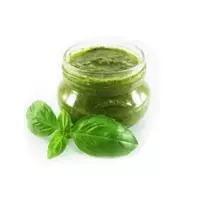Canned basil

The main feature of the basilica is its peculiar taste and bright exquisite aroma, which is worthy of kings. Today, breeders have successfully bred a considerable number of the most diverse varieties of basil, which, unlike their exclusively green progenitor, boast a variety of colors.
Thus, many shades of purple are characteristic of the cultural varieties of modern types of basil, although green-colored varieties still delight consumers with their unsurpassed taste, are popular and in stable demand among culinary experts in many countries of the world.
It is noteworthy that the basilica began its victorious procession around the world from the South Asian countries and Transcaucasia. So, initially this is a very aromatic plant, which also has a number of useful properties, was grown in Ceylon, India and Iran, after which the basil entered Europe (Italy, southern France and many other regions). Today, this tasty green is popular in many of the world's cuisines, where it is used in the preparation of a mass of delicious dishes.
For example, fresh basil leaves are used as a savoury snack and fragrant seasoning. By the way, the seeds of this plant have also found their use in the cuisine of Azerbaijan - they flavour various drinks, pates, salads or soups, giving the finished dishes a kind of savory taste. In addition, basil greens work perfectly with dishes made with lamb, beef, various offal or poultry.
The role of basil is also important for the aromatization of canned vegetables, marinades, sauces, oils and vinegars. Crushed greens of this fragrant plant are often added to the composition of aromatic compositions, as it has a slightly cold tart-bitter flavor and a spicy aroma. Often, canned basil is harvested for future use, which is then used not only as a savoury additive, but also as a side dish.
In order to prepare homemade canned basil, it is necessary to cut plants at a height of about ten centimeters from the surface of the soil. Fresh basil leaves are carefully traversed, with yellowish, damaged and thick stems discarded. After that, the fresh greens are either poured with cool boiling water or blanched for no more than a minute over a high heat. The prepared basil is reclined in a colander, and then, if desired, crushed in a meat grinder, knife or wiped through a sieve.
The resulting green mass warms up for some time, after which salt, sugar and an acidic component, which plays the role of a natural preservative, are added to taste. Jars of canned basil are sterilized and rolled up. As a result, canned basil is a delicious product that can be seasoned with a variety of first and second courses, snacks and salads.
canned basil 23 kCal
Energy value of canned basil (Ratio of proteins, fats, carbohydrates - ju):
Proteins: 3.15 g (~ 13 kCal)
Fats: 0.64 g (~ 6 kCal)
Carbohydrates: 1.05 g (~ 4 kCal)
Energy ratio (bj | y): 55% | 25% | 18%
 Español
Español Français
Français Português
Português Русский
Русский 简体中文
简体中文 繁體中文
繁體中文 日本語
日本語 한국어
한국어 العربية
العربية Türkçe
Türkçe Қазақ
Қазақ Deutsch
Deutsch Italiano
Italiano Українська
Українська
